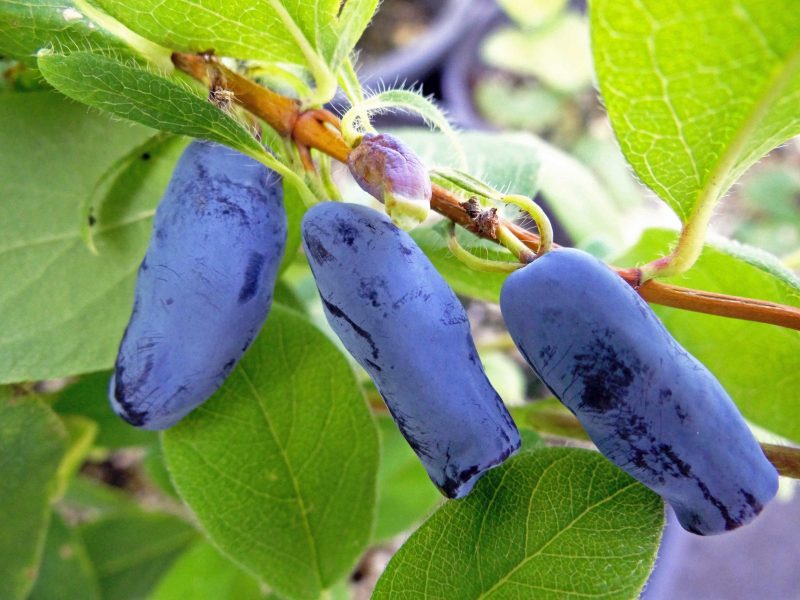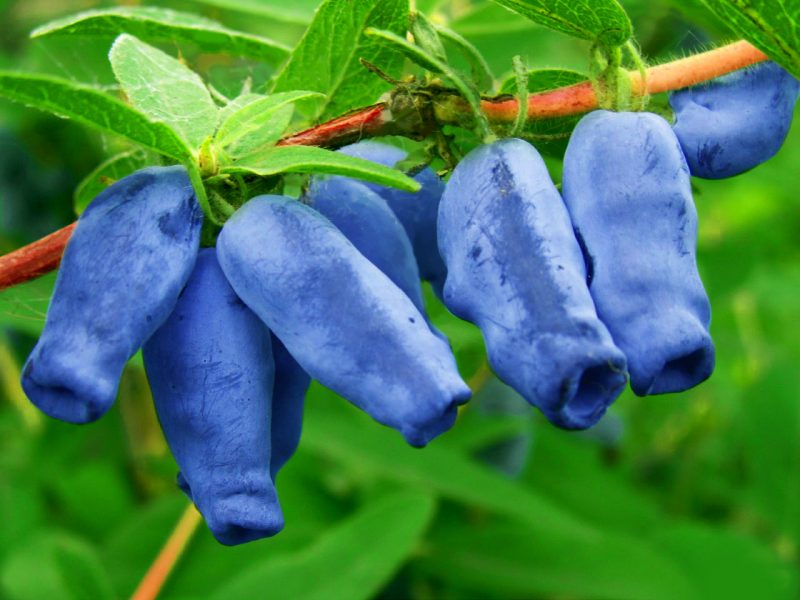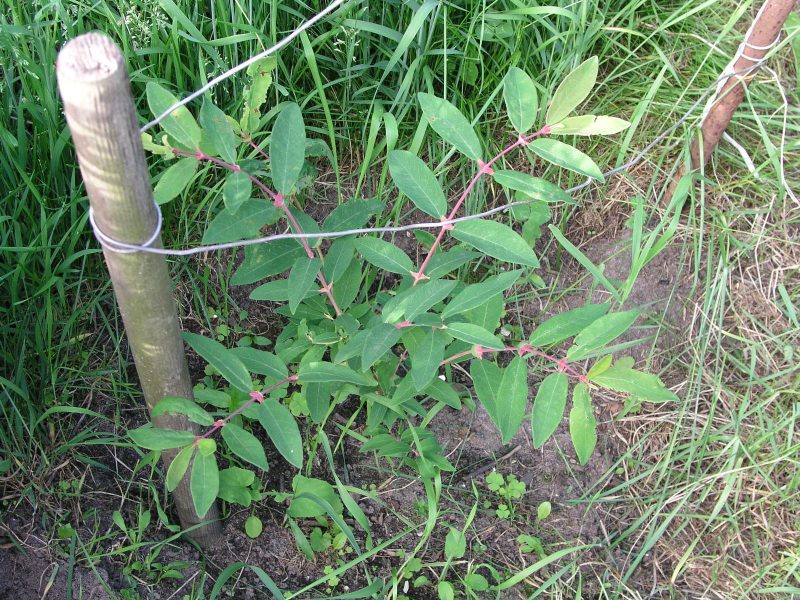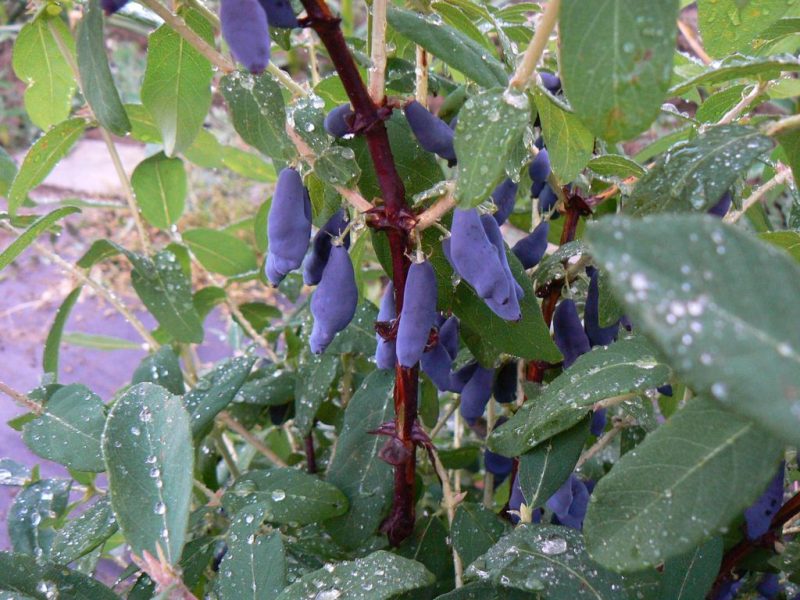Many summer residents think: how to propagate honeysuckle from a bush? There is nothing complicated - a little effort is enough for the honeysuckle to take root perfectly and produce rich harvests. We will tell you about this method of planting, give useful tips on care and pest control.
Material Content:
How to propagate honeysuckle from a bush?
Honeysuckle can be considered a real gift of nature for everyone who lives in the northern regions of the country. The unpretentious shrub easily tolerates even severe frosts and already in the beginning of summer pleases with a harvest of fragrant berries with sourness.

Honeysuckle is a new plant for our latitudes, and it can be difficult to get its seedlings. But if you noticed a fluffy bush with flowers in the form of panicles among your neighbors - do not be shy, ask for planting material, because it’s easy to propagate the honeysuckle from the bush.
How to do it? We proceed by stages:
- In September (or March) we dig a bush from the ground.
- Carefully shake the ground from the roots.
- Divide the secateurs into 2-3 parts, including the roots.
- Sections are disinfected with a solution of potassium permanganate.
- Each bush is planted separately in pre-prepared soil.
To propagate honeysuckle by dividing the bush, a young, healthy plant with a developed root system is suitable. Plants older than 5 years old are not suitable for the role of uterine ones: there is a risk that the root system will not be able to recover after a “shake”, begin to rot and gradually die. So for adult shrubs it is better to choose other breeding methods.
A little about other methods of plant propagation
If there are no parental shrubs in mind, or they turned out to be inappropriate, look for a new method, good, there are several of them.

Popular honeysuckle landing:
- by seeds;
- cuttings;
- layering;
- green cuttings.
For planting seeds, only edible varieties of honeysuckle, not hybrid, are suitable. Breeding is possible through the seeds of large ripe berries. Their bones are selected, washed with water and planted in peat pots, sprinkled with earth 2-3 cm. The plant will sprout faster under the greenhouse effect: we cover the pots with cling film or polyethylene and create a cozy microclimate for the seeds.
While the sprouts germinate, it is important to ensure that the soil does not dry out and periodically water it with water. Be prepared to “nurse” with seedlings for a year - only after 12 months the sprouts will grow stronger, ready to be transplanted into the open ground. The best planting time is April and May, when the soil has already been warmed up.
When propagated by seeds, berries can change taste, and yield, compared with the parent plant, decrease.
Propagation by cuttings begins in the fall, harvesting lignified shoots. This is best done in early October. Cut the shoots, wrap them in a cotton cloth, put in a bucket pre-filled to half with sawdust or sand. We store cuttings all winter and planted in early spring (the snow had barely melted). We plant shoots at an angle of 5 degrees, leaving 2-3 buds on the surface. Cuttings should take root in about a month, but, alas, only 20% of all seedlings take root.
You can propagate honeysuckle with green cuttings. They are taken immediately after the bush has bloomed, but the berries have not yet been tied. A green shank 10-13 cm long is separated from the bush, divided into several parts, 2-3 buds are left on them, and then soaked in water for 24 hours. A day later, we plant the plant in open ground, covering the wells with polyethylene. Be sure to warm the young bush for the winter, otherwise it will freeze.
People's advice: honeysuckle - useful properties and contraindications
Breeding with layering is considered a simple way. The parent bush is loosened from all sides, watered abundantly and we select several young shoots that grow at the very bottom of the bush. The shoots are pressed to the soil, dug 4 cm deep into the ground. After a year, we separate the shoots with a shovel, transplanted to a permanent place. If everything is done correctly, then after 3-4 years a beautiful fluffy honeysuckle bush should form on the site.
Edible honeysuckle planting
Very often, summer residents are faced with a problem when edible honeysuckle is planted according to all the rules, but the plant does not bear fruit. The barren shrub remains without pollination, and it is realistic to avoid trouble if you use planting material of not one, but several varieties of honeysuckle. As practice shows, three varieties are best established.

“Tenacious” varieties:
- Blue bird (bushes grow to 1.5 m and bear fruit with elongated berries weighing 0.8 g of sweet and sour taste).
- Titmouse (2 m tall bushes with large sweet berries).
- Blue spindle (bushes grow to 1.8 m, the berries are fleshy, sweet, without bitterness).
But no matter what variety you choose, follow the planting technology. Plants are planted in places that are protected from the wind. Before planting, you need to inspect the roots, remove the dry parts. Use drainage for better agricultural technology. Water is poured into the hole, the shoot is planted, spreading the roots well - the plant should not be deepened too much so as not to slow its growth.
Honeysuckle is not capricious, and well rooted in almost any soil, although it prefers loamy soil.

Now it’s important to once again spill the hole with water mixed with compost and mulch it well - this way the moisture will not run away. As mulching material, even twisted sheets of newspaper are suitable. The shrub will grow faster if you feed the soil with any organic fertilizer and do not forget to water it: honeysuckle is very fond of moisture.
"Kids" is important to periodically feed. To do this, mix 10 g of urea, nitrate with 10 liters of water and water the bush directly under the roots. And try not to loosen the ground for the first year - it is so easy to damage the delicate roots.
Honeysuckle is often grown instead of hedges, protecting the house from prying eyes, or the scorching sun.
Unlike edible, decorative honeysuckle does not give sweet berries, but it is spectacular and always adorns a personal plot with long flowering. The variety Honeysuckle looks beautiful. This is a climbing vine up to 6 meters high with large oval leaves. On the one hand, the leaves are green, on the other - bluish smoky, and in the fall they change color to yellow-purple.
Outdoor Care
Honeysuckle care is generally simple, because the culture is not demanding at all. But gardeners will have to remember a few rules.
- Do the cropping. In spring, autumn, when there is no bright sun, we remove weak, damaged branches.
- We rejuvenate old bushes, cutting them about 50 cm from the ground.
- Twice a year, we feed the plant with organic, mineral fertilizers.
- Water the shrub moderately. Reduce the intervals of watering in the heat and the ripening period of berries. We increase the amount of water. So the fruits will not be bitter, and the yield will increase.
- After collecting the fruit, cut the shoots that have faded in half. We treat bushes with Bordeaux liquid for the prevention of fungus.
Many summer residents once a year - in the spring - always spruce the bush and add mulch. Such measures help the bush to become more magnificent, and all summer to please the eye with green leaves.
Diseases and pests of bushes
Honeysuckle rarely gets sick, but aptly. Sometimes pests and diseases attack it so hard that the plant dies in a matter of weeks. In the power of any gardener to prevent the death of a beautiful useful culture.

Signs of illness:
- Yellowed leaves. This often happens due to the attack of honeysuckle aphids. You can overcome the pest with garlic, pepper tinctures and systemic insecticides.
- Dark spots, dried leaves. They give out the presence of ticks that affect the thickened plantings. Shrubs urgently need to be thinned out and treated with insecticides - folk methods are often useless.
- Spoiled unripe berries. This means that honeysuckle was attacked by pollen, and therefore it should be quickly pollinated with tinctures from tomato and potato tops or with special chemicals.
- Whitish coating indicates the presence of powdery mildew. The plant is treated with wood ash and chemical poisons.
- Pale spots on the leaves, black patches on the veins. Signs of phytovirus infection. Unfortunately, it is impossible to cure the shrub. It remains only to dig up the bush and burn it, so as not to infect the rest of the plants in the garden.
Honeysuckle rarely gets sick, remains green all summer season, pleases the eye with flowers, and then with fruits.
Honeysuckle shrubs are grateful, generous plants that quickly respond to any care. Try planting the honeysuckle on the site, and soon all the neighbors will ask you for cuttings. Have a rich harvest!












